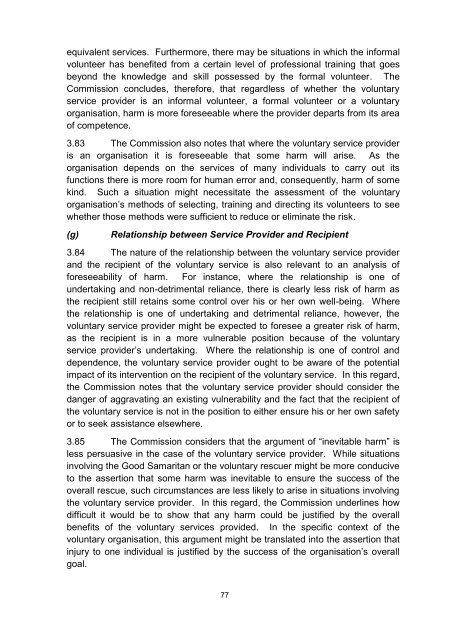civil liability of good samaritans and volunteers - Law Reform ...
civil liability of good samaritans and volunteers - Law Reform ...
civil liability of good samaritans and volunteers - Law Reform ...
Create successful ePaper yourself
Turn your PDF publications into a flip-book with our unique Google optimized e-Paper software.
equivalent services. Furthermore, there may be situations in which the informalvolunteer has benefited from a certain level <strong>of</strong> pr<strong>of</strong>essional training that goesbeyond the knowledge <strong>and</strong> skill possessed by the formal volunteer. TheCommission concludes, therefore, that regardless <strong>of</strong> whether the voluntaryservice provider is an informal volunteer, a formal volunteer or a voluntaryorganisation, harm is more foreseeable where the provider departs from its area<strong>of</strong> competence.3.83 The Commission also notes that where the voluntary service provideris an organisation it is foreseeable that some harm will arise. As theorganisation depends on the services <strong>of</strong> many individuals to carry out itsfunctions there is more room for human error <strong>and</strong>, consequently, harm <strong>of</strong> somekind. Such a situation might necessitate the assessment <strong>of</strong> the voluntaryorganisation‟s methods <strong>of</strong> selecting, training <strong>and</strong> directing its <strong>volunteers</strong> to seewhether those methods were sufficient to reduce or eliminate the risk.(g)Relationship between Service Provider <strong>and</strong> Recipient3.84 The nature <strong>of</strong> the relationship between the voluntary service provider<strong>and</strong> the recipient <strong>of</strong> the voluntary service is also relevant to an analysis <strong>of</strong>foreseeability <strong>of</strong> harm. For instance, where the relationship is one <strong>of</strong>undertaking <strong>and</strong> non-detrimental reliance, there is clearly less risk <strong>of</strong> harm asthe recipient still retains some control over his or her own well-being. Wherethe relationship is one <strong>of</strong> undertaking <strong>and</strong> detrimental reliance, however, thevoluntary service provider might be expected to foresee a greater risk <strong>of</strong> harm,as the recipient is in a more vulnerable position because <strong>of</strong> the voluntaryservice provider‟s undertaking. Where the relationship is one <strong>of</strong> control <strong>and</strong>dependence, the voluntary service provider ought to be aware <strong>of</strong> the potentialimpact <strong>of</strong> its intervention on the recipient <strong>of</strong> the voluntary service. In this regard,the Commission notes that the voluntary service provider should consider thedanger <strong>of</strong> aggravating an existing vulnerability <strong>and</strong> the fact that the recipient <strong>of</strong>the voluntary service is not in the position to either ensure his or her own safetyor to seek assistance elsewhere.3.85 The Commission considers that the argument <strong>of</strong> “inevitable harm” isless persuasive in the case <strong>of</strong> the voluntary service provider. While situationsinvolving the Good Samaritan or the voluntary rescuer might be more conduciveto the assertion that some harm was inevitable to ensure the success <strong>of</strong> theoverall rescue, such circumstances are less likely to arise in situations involvingthe voluntary service provider. In this regard, the Commission underlines howdifficult it would be to show that any harm could be justified by the overallbenefits <strong>of</strong> the voluntary services provided. In the specific context <strong>of</strong> thevoluntary organisation, this argument might be translated into the assertion thatinjury to one individual is justified by the success <strong>of</strong> the organisation‟s overallgoal.77
















